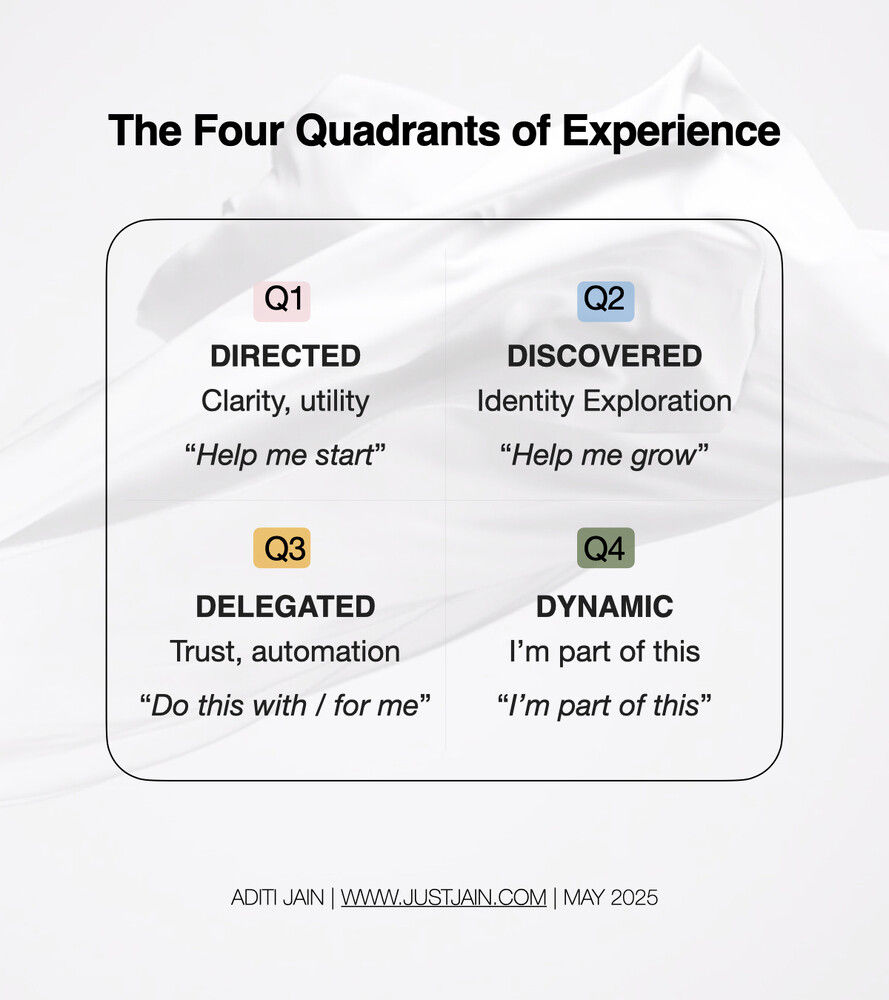Designing digital experiences that evolve with systems thinking
- Aditi Jain
- Jun 30
- 2 min read
Updated: Jul 2

TLDR: Digital products often stall at clarity and conversion. This piece introduces the Experience Matrix, a four-quadrant framework (Directed, Discovered, Delegated, Dynamic) that helps tech orgs evolve user experiences across identity shifts, automation, and belonging. With real-world examples and a poetic lens, we explore how systems can scale without losing soul.
Tech is maturing.
Outside of building fast, it’s about building in rhythm with people’s lives. And yet, most digital experiences are stuck: over-optimized for conversion, underdesigned for continuity.
What we need now isn’t more features. It’s frameworks, not simply MVPs, but meaningful velocity paths.
Enter:
The Experience Matrix, a quadrant model I use to help tech orgs evolve from task delivery to ritual design.

These quadrants mirror real user evolution: onboarding, self-discovery, automation, and ritual. The magic? You don’t design just for one; you build across all four.
A real example: Scaling a service-based model into product mode
Recently, I led experience strategy for a creative consultancy navigating a transition: From high-touch, bespoke projects → to scalable, semi-automated offerings. The challenge? Maintaining soul at scale.
We mapped the transformation using the matrix:
Q1 (Directed): Clear entry flows, self-booking, tiered service menus (“Spark", “Scope,” “Spell”)
Q2 (Discovered): Archetype quiz + zine system to align clients to narrative lenses
Q3 (Delegated): AI-generated proposals and branded Notion OS for auto-prep
Q4 (Dynamic): Ritual-based client engagement, seasonal salons, creative check-ins, story-based milestones
The result? Better ops and experience. Aesthetic autonomy.

Field note: Designing digital experience for multiplicity
The evolution is no longer linear, it’s layered. We move through clarity, story, structure, and rhythm like a well-cut garment: tailored, intentional, becoming. This is the matrix we wear: quadrant-coded, experience-forward.
This is the future of tech design:
Systems that hold more than one self
Interfaces that reflect identity, not just capture behaviour
In experience strategy, this matters deeply. The same user can be:
A founder on Monday
A parent on Tuesday
A dreamer on Wednesday night
So we design not for the moment, but for the rhythm.
Not just for the user journey, but for their life arc.
Let your digital presence be like this visual: elegant, elastic, and whole.
Design for who they're becoming
I built with a thesis: people don’t stay static, and neither should your experience.
The best tech products evolve with the user:
From frictionless setup (Q1)
To narrative resonance (Q2)
To trust-led delegation (Q3)
To rituals of belonging (Q4)
If you're building in AI, SaaS, creator tools, or systems design, start asking not “What does the user want now?”, but “What season of identity are they in?”
Because velocity isn’t enough. We need experiential gravity.
Ready to map your product across the matrix or prototype rituals at scale? Let’s evolve the experience. Drop me a line.
Published initially in Bytes with JustJain, where digital clarity meets creative systems thinking.


Comments